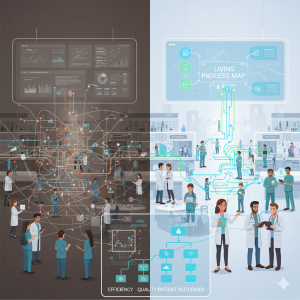
Healthcare has always been a complex ecosystem. Unlike banking or retail, where processes are largely transactional, healthcare involves human lives, clinical decisions, regulatory scrutiny, and high emotional stakes. Every patient journey spans multiple touchpoints, admissions, diagnostics, treatment, billing, discharge, follow-up, and each step generates data.
But despite massive investments in electronic health records (EHRs), digital tools, and AI-driven solutions, many healthcare organisations still struggle with visibility. They know data exists but lack a holistic view of how processes actually work in practice. This results in delays, bottlenecks, and inefficiencies that undermine patient experience and drive up costs.
Enter process mining, a discipline that transforms raw data into living process maps, exposing the reality behind the idealised workflows written in manuals or PowerPoints.
Why Process Mining Matters in Healthcare
Think of a hospital as a city. Every department is a neighbourhood, departments like pharmacy, radiology, surgery, finance, insurance. Patients are the citizens, moving through multiple intersections. But if traffic signals don’t sync, if roads are blocked, or if shortcuts are invisible, chaos ensues.
Process mining acts as the traffic control system, uncovering hidden routes, signalling bottlenecks, and showing where delays or compliance breaches occur. Unlike surveys or manual audits, process mining relies on actual data footprints across EHRs, scheduling software, claims systems, and supply chains.
For healthcare leaders, this means:
- No more assumptions, only facts.
- End-to-end visibility across the patient journey.
- Objective insights to redesign processes around efficiency and care quality.
The Unique Challenges Healthcare Faces
Digital transformation in healthcare isn’t about implementing technology alone. It’s about navigating unique structural and cultural barriers:
- Legacy Technology: Decades-old clinical systems often don’t play nicely with modern cloud solutions, creating data silos.
- Fragmented Journeys: A single patient may interact with dozens of departments, labs, or external partners, each with its own system.
- Regulatory Load: Compliance with HIPAA, GDPR, or local health authority mandates can slow transformation initiatives.
- Workforce Pressure: Clinicians and staff are already stretched thin. Asking them to adopt new workflows without clear value risks resistance.
- Cybersecurity Stakes: Patient data is one of the most sensitive assets in any sector, making healthcare a prime cyber target.
These challenges explain why many well-funded digital projects fail to achieve intended outcomes. Technology is introduced, but processes remain broken.
How Process Mining Creates Value in Healthcare
When applied thoughtfully, process mining can turn these challenges into opportunities:
- Streamlining Patient FlowsIdentify delays in admissions, diagnostic turnaround, or discharge processes. For example, if lab results consistently take longer than expected, process mining pinpoints whether it’s a staffing issue, system delay, or procedural bottleneck.
- Optimising Clinical OperationsOperating theatres are some of the most expensive hospital assets. In radiation oncology, process mining revealed planning delays and improved throughput, reducing time-to-treatment for patients. It can reveal why surgeries are delayed, whether due to patient prep, equipment availability, or scheduling conflicts, allowing hospitals to recover lost time and increase throughput.
- Improving Compliance and SafetyIn clinical pathways, deviations can have life-or-death consequences. Process mining enables real-time monitoring of adherence to treatment protocols, helping ensure patient safety and reducing medico-legal risks.
- Reducing Administrative WasteClaims and procurement processes are ripe for simplification. Research combining Kaizen with process mining demonstrates how inefficiencies can be eliminated and sustainable improvements embedded.
- Driving Better Patient OutcomesUltimately, every efficiency gained translates into faster, safer, and more personalised care. For example, reducing discharge delays not only improves patient satisfaction but also increases bed availability for others. National-scale work on older adult patient journeys shows how process mining reveals systemic choke points that, when resolved, free capacity and improve outcomes
Beyond Efficiency: The Strategic Role of Process Mining
Healthcare leaders often think of process mining as a tool for fixing inefficiencies. But its value extends far deeper:
- Evidence-Based Transformation: Instead of relying on consultant slides or anecdotal staff feedback, leaders can ground transformation strategies in hard data.
- Continuous Improvement: Unlike one-off audits, process mining creates a living digital twin of operations, enabling constant refinement.
- Cross-Sector Collaboration: Health systems can analyse interactions with insurers, suppliers, or government agencies, creating transparency across the ecosystem.
- Foundation for AI: Clean, well-structured process data becomes the backbone for AI-driven decision support, predictive analytics, and automation.
Moving Forward: From Visibility to Impact
Healthcare is at a crossroads. Costs are rising, demand is increasing, and resources are under strain. Digital transformation is no longer optional, but without clear visibility into processes, technology investments risk becoming expensive patchwork.
Process mining doesn’t just show you where the cracks are; it gives you the tools to repair them, monitor progress, and embed a culture of continuous improvement.
The payoff will be Hospitals that run like well-coordinated ecosystems. Clinicians with more time for patients. Administrators with real-time control. And patients who experience healthcare as it should be, timely, safe, and centred on them.
